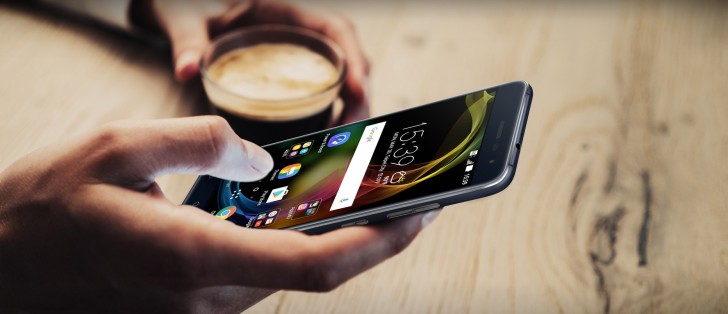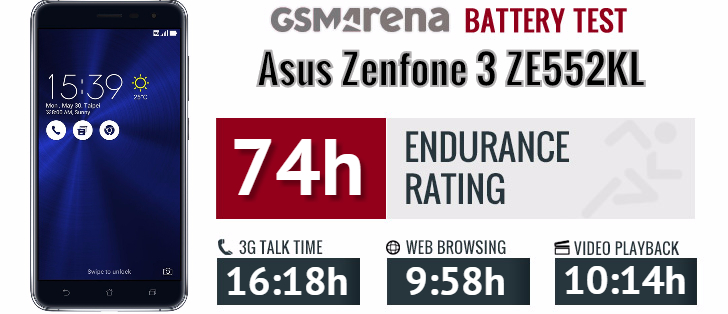Asus Zenfone 3 ZE552KL review: More than meets the eye
More than meets the eye

Display
The Asus Zenfone 3 ZE552KL sports a 5.5" screen with 1080p resolution. It's a Super IPS+ panel with excellent viewing angles and impressive brightness - Asus promises 600nits! It also promised 100% NTSC color coverage, which would make this a truly impressive display.
Our measurements confirm the 600nits of brightness claim - easily achievable in manual mode, Auto mode offers no additional boost so you are in full control. At full blast, the black levels remain quite reasonable at 0.45nits for 1,300:1 contrast ratio. That's comparable to the iPhone 7 Plus screen and better than the LG V20 screen.

The Zenfone 3 screen has amazing range, it managed to get down to just 4.9nits when we dragged the brightness slider to minimum. There's also a blue light filter toggle in the notification area to further improve late night viewing (checking a 600nit phone at night is painful, trust us. Also blue light can mess up your sleep cycle).
| Display test | 100% brightness | ||
| Black, cd/m2 | White, cd/m2 | ||
| 0.448 | 607 | 1355 | |
| 0.00 | 422 | ∞ | |
| 0.00 | 625 | ∞ | |
| 0.31 | 397 | 1281 | |
| 0.43 | 475 | 1097 | |
| 0.59 | 628 | 1064 | |
| 0.41 | 573 | 1398 | |
| 0.50 | 681 | 1362 | |
While bright and with high contrast, the high reflectivity of screen keeps its sunlight legibility score relatively low. LCDs of similar brightness do better - sometimes much better. True, they are usually flagships, but a 3+ score is not unexpected when we're talking 600nits. Even dimmer screens can score higher (both LCD and AMOLED).
Sunlight contrast ratio
-
Samsung Galaxy S6 edge+
4.615 -
Samsung Galaxy S7 edge
4.439 -
OnePlus 3
4.424 -
Samsung Galaxy S7
4.376 -
HTC One A9
4.274 -
Samsung Galaxy Note7
4.247 -
Samsung Galaxy A3
4.241 -
Google Pixel XL
4.164 -
ZTE Axon 7
4.154 -
Samsung Galaxy S6 edge
4.124 -
Samsung Galaxy Note5
4.09 -
Huawei Nexus 6P
4.019 -
Vivo Xplay5 Elite
3.983 -
OnePlus X
3.983 -
Oppo R7s
3.964 -
Apple iPhone 7
3.964 -
Huawei P9 Plus
3.956 -
Samsung Galaxy A7 (2016)
3.918 -
Samsung Galaxy C5
3.911 -
Samsung Galaxy C7
3.896 -
Samsung Galaxy A5
3.895 -
Samsung Galaxy J7 outdoor
3.879 -
Samsung Galaxy J2 outdoor
3.873 -
Samsung Galaxy A8
3.859 -
Samsung Galaxy A9 (2016)
3.817 -
Motorola Moto X (2014)
3.816 -
Samsung Galaxy J7 (2016) outdoor mode
3.802 -
Xiaomi Redmi Pro
3.798 -
LG V20 Max auto
3.798 -
Sony Xperia XZ
3.795 -
Samsung Galaxy A5 (2016)
3.789 -
Apple iPhone 6s
3.783 -
Meizu Pro 5
3.781 -
Microsoft Lumia 650
3.772 -
Samsung Galaxy J7 (2016)
3.756 -
Oppo F1 Plus
3.709 -
Vivo X5Pro
3.706 -
Sony Xperia X Compact
3.694 -
Apple iPhone SE
3.681 -
Samsung Galaxy A7
3.679 -
Meizu PRO 6
3.659 -
BlackBerry Priv
3.645 -
Apple iPhone 7 Plus
3.588 -
Apple iPhone 6s Plus
3.53 -
Samsung Galaxy J3 (2016)
3.523 -
Samsung Galaxy J3 (2016) outdoor mode
3.523 -
Acer Jade Primo
3.521 -
Microsoft Lumia 950
3.512 -
Oppo R7 Plus
3.499 -
nubia Z11
3.466 -
Samsung Galaxy J7
3.422 -
Meizu MX5
3.416 -
LG V20
3.402 -
Oppo R7
3.32 -
Xiaomi Mi 5s
3.276 -
Samsung Galaxy J2
3.235 -
Sony Xperia X Performance
3.234 -
Motorola Moto X Play
3.222 -
Huawei P9
3.195 -
Lenovo Vibe Shot
3.113 -
Motorola Moto X Force
3.105 -
LG Nexus 5X
3.092 -
Huawei Mate S
3.073 -
Microsoft Lumia 640 XL
3.065 -
Sony Xperia X
2.989 -
Huawei Mate 8
2.949 -
Xiaomi Redmi 3S
2.913 -
Sony Xperia XA Ultra
2.906 -
LG G5
2.905 -
HTC One S
2.901 -
Xiaomi Mi 5s Plus
2.884 -
Sony Xperia Z5
2.876 -
Microsoft Lumia 550
2.851 -
Xiaomi Redmi 3 Pro
2.803 -
Sony Xperia Z5 compact
2.784 -
Meizu MX6
2.751 -
LG V10
2.744 -
Xiaomi Redmi 3
2.735 -
Sony Xperia M5
2.69 -
Huawei P9 Lite
2.679 -
Vivo V3Max
2.659 -
Xiaomi Mi 4i
2.641 -
Sony Xperia XA
2.609 -
Motorola Moto G4 Plus
2.582 -
Motorola Moto G4 Plus (max auto)
2.582 -
Xiaomi Mi 4c
2.574 -
LeEco Le Max 2
2.567 -
Microsoft Lumia 640
2.563 -
Asus Zenfone 3 ZE552KL
2.563 -
Lenovo Moto G4
2.544 -
Oppo F1
2.528 -
Sony Xperia Z5 Premium
2.525 -
Huawei Honor 7 Lite / Honor 5c
2.506 -
Sony Xperia M4 Aqua
2.503 -
Oppo F1s
2.481 -
Motorola Moto G
2.477 -
Lenovo Vibe K5 Plus
2.473 -
Huawei G8
2.471 -
Huawei nova
2.467 -
Sony Xperia Z
2.462 -
Lenovo Vibe K5
2.459 -
Huawei Honor 7
2.406 -
Sony Xperia E5
2.386 -
ZUK Z1 by Lenovo
2.382 -
HTC 10
2.378 -
Samsung Galaxy J5 (2016)
2.378 -
Huawei nova plus
2.329 -
HTC One E9+
2.305 -
Alcatel One Touch Hero
2.272 -
Apple iPhone 4S
2.269 -
Lenovo Vibe K4 Note
2.254 -
Sony Xperia C5 Ultra
2.253 -
Xiaomi Redmi Note 3 (MediaTek)
2.249 -
Sony Xperia C4 Dual
2.235 -
Xiaomi Mi Note
2.234 -
Motorola Moto G (2014)
2.233 -
LG Nexus 5
2.228 -
Huawei P8
2.196 -
Huawei Honor 6
2.169 -
Xiaomi Redmi Note 2
2.166 -
OnePlus Two
2.165 -
HTC One X
2.158 -
Xiaomi Redmi Note 4
2.145 -
LG Aka
2.145 -
Archos 50 Diamond
2.134 -
Xiaomi Redmi Note
2.119 -
Xiaomi Mi 4S
2.095 -
Acer Liquid X2
2.084 -
Huawei P8lite
2.078 -
Moto G 3rd gen max manual
2.026 -
Xiaomi Mi Max
1.996 -
Sony Xperia E4g
1.972 -
OnePlus One
1.961 -
Meizu m3 note
1.923 -
BlackBerry Leap
1.892 -
Meizu m2 note
1.892 -
ZTE Nubia Z9 mini
1.759 -
Sony Xperia U
1.758 -
Asus Zenfone Selfie
1.68 -
Motorola Moto E (2nd Gen)
1.675 -
ZTE Nubia Z9
1.659 -
Jolla Jolla
1.605 -
Motorola Moto E
1.545 -
Sony Xperia M
1.473 -
HTC Desire C
1.3 -
Sony Xperia C
1.283 -
Meizu MX
1.221 -
Sony Xperia E
1.215
From the settings you can access the Splendid app, which is used to adjust the screen colors. The default Balance mode is not that accurate with a cold white balance and an average deltaE of 5.5 (max 9.7). Vivid mode pumps up the contrast and saturation for extra punch at the cost of accuracy.
We found that staying on Balance mode and dragging the Color temperature slider all the way to the right offered much better color accuracy - average of 2.8 (very good) and improved maximum of 5.7. Not as good as the leading flagships, but better than the LG V20 and close to the Pixel XL.
You can manually adjust the Hue and Saturation sliders, which can create some psychedelic results, but is not particularly useful otherwise.
The VisualMaster 3.0 technology promises 100% NTSC color coverage. For comparison, sRGB is just 72% NTSC. This is distinct from color accuracy, it's about how many colors can be displayed (similar to Apple's Wide Color). Of course, you'll need the right content to benefit from this and most content out there is limited to sRGB.
Connectivity
The Asus Zenfone 3 ZE552KL is based on the Snapdragon 625 chipset, which delivers Cat. 7 speeds - up to 300Mbps downlink and 50Mbps uplink, thanks to 2-carrier aggregation. Both SIMs can be used for LTE.
The phone has two phone lines, which enjoy VoLTE for higher quality sound. Asus says the Zenfones are more resilient to signal dropouts than, ahem, a certain Cupertino-based competitor. The noise reduction will help VoLTE do its best even in noisy environments.
Local wireless connectivity is shored up with dual-band Wi-Fi up to 802.11ac. Bluetooth is version 4.2, then there's NFC. Positioning is covered by GPS, GLONASS and Beidou.
The Zenfone 3 has a USB Type-C port on the bottom, which is wired only for USB 2.0 speeds.
Battery life test
Update: We completed the battery tests, here are the full results.
The 3,000mAh battery capacity is about average for a 5.5" phone, certainly, there are others with a few hundred milliamp hours more. The phone bets on the super-efficient Snapdragon 625 chipset, which is built on a 14nm fabrication process (most mid-range chipsets are built on a 28nm process, which is not nearly as efficient).
Note that while our retail package came with a regular 5V 2A charger, the phone supports Quick Charge 3.0, which boosts charging speed from 10W to up to 18W. The battery is not removable, so quick top ups can save your bacon.
Both web browsing and video playback took 10 hours to drain the Zenfone's battery. That's better than, say, an LG V20 (3,200mAh), which lasted about 8 hours on both. A Huawei nova plus (3,340mAh) lasts 11:30 and 10:30 hours respectively, so in the same ballpark. The Samsung Galaxy C7 (both it and the nova use Snapdragon 625) went up to about 15 hours for both tests, really stretching its 3,300mAh battery, even with its bigger 5.7" screen.
The talk time is good though not stellar. More importantly, the Endurance rating came out to a good 74 hours - about as good as the Huawei nova plus, though not living up to Galaxy C7's 100 hours. It's better than the LG V20 flagship, though.

The battery testing procedure is described in detail in case you're interested in the nitty-gritties. You can also check out our complete battery test table, where you can see how all of the smartphones we've tested will compare under your own typical use.
Reader comments
- Vahid
- 27 Jul 2021
- M@n
This is so true. My brother and i purchased this one and rear camera broken.
- isti
- 21 Nov 2020
- thw
what phone can change this one in 2020, i'm used this from 2017 until now and i want to retired this one, which one i can choose if i want like this but with bigger batteray, bigger ram and rom, better camera etc ... but not too expensive thanx ...
- Asusneveragain
- 22 Mar 2020
- rRT
I have never hated an electronic device as much as this phone. If for some reason you want a phone from 2016, DON'T BUY THIS ONE! Rear camera focus stopped working at one year of use. Bluetooth shortcut sometimes does not function, underpowered pr...